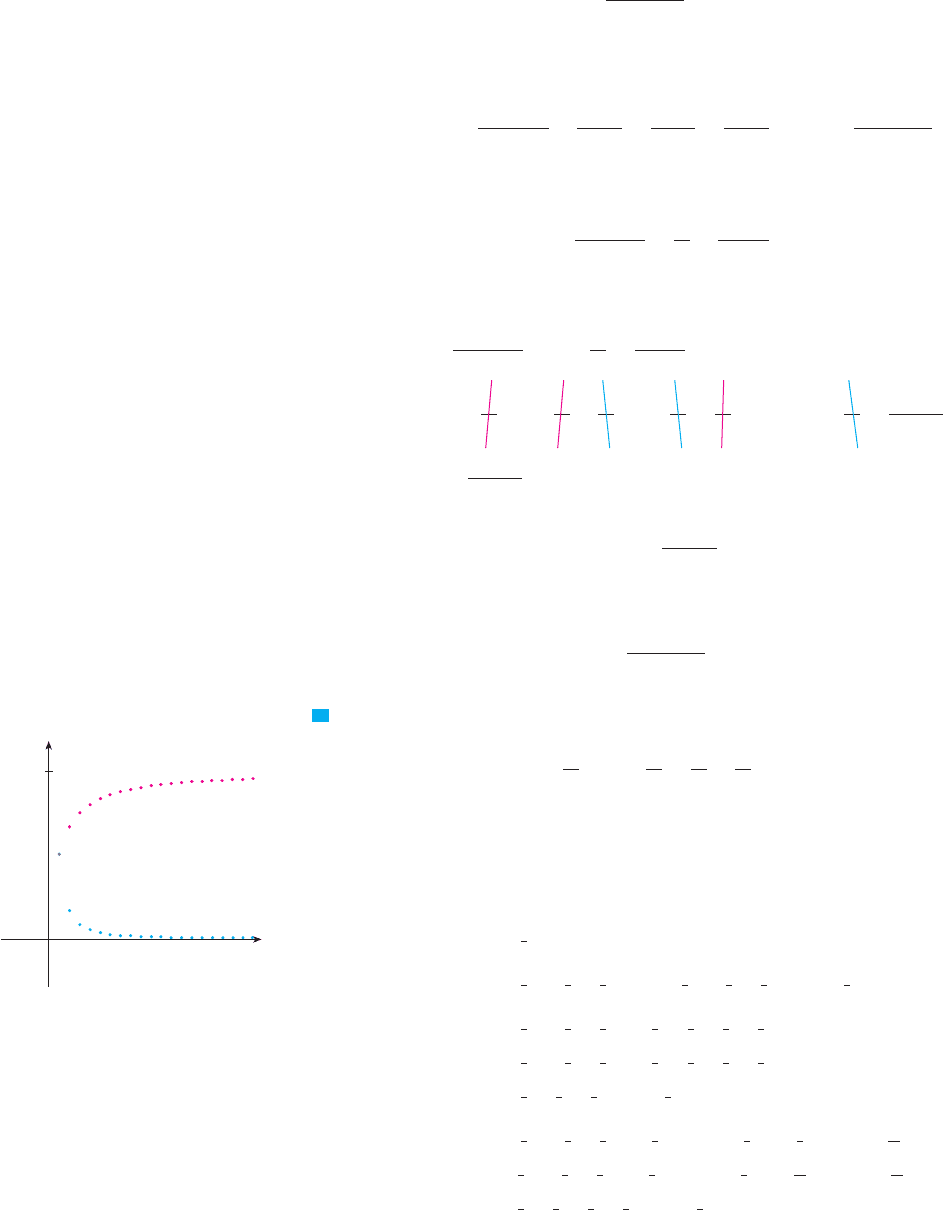Stewart J. Calculus
Подождите немного. Документ загружается.


722
|| ||
CHAPTER 12 INFINITE SEQUENCES AND SERIES
(e) Use parts (c) and (d) to show that for all .
(f) Use Theorem 12 to show that exists.
(The limit is . See Equation 7.4.9 or 7.4*.9.)
79. Let and be positive numbers with . Let be their
arithmetic mean and their geometric mean:
Repeat this process so that, in general,
(a) Use mathematical induction to show that
(b) Deduce that both and are convergent.
(c) Show that . Gauss called the
common value of these limits the arithmetic-geometric
mean of the numbers and .
80. (a) Show that if and ,
then is convergent and .
(b) If and
find the first eight terms of the sequence . Then use
part (a) to show that . This gives the
continued fraction expansion
81. The size of an undisturbed fish population has been modeled
by the formula
where is the fish population after years and and are
positive constants that depend on the species and its environ-
ment. Suppose that the population in year 0 is .
(a) Show that if is convergent, then the only possible
values for its limit are 0 and .
(b) Show that .
(c) Use part (b) to show that if , then ;
in other words, the population dies out.
(d) Now assume that . Show that if , then
is increasing and . Show also that
if , then is decreasing and .
Deduce that if , then .lim
n
l
"
p
n
! b & a
a
#
b
p
n
% b & a# p
n
$p
0
% b & a
0
#
p
n
#
b & a# p
n
$
p
0
#
b & a
a
#
b
lim
n
l
"
p
n
! 0a % b
p
n!1
#
!b%a"p
n
b & a
# p
n
$
p
0
% 0
banp
n
p
n!1
!
bp
n
a ! p
n
s
2
! 1 !
1
2 !
1
2 ! ' ' '
lim
n l "
a
n
!
s
2
#a
n
$
a
n!1
! 1 !
1
1 ! a
n
a
1
! 1
lim
n l "
a
n
! L#a
n
$
lim
n l "
a
2n!1
! Llim
n l "
a
2n
! L
ba
lim
n
l
"
a
n
! lim
n
l
"
b
n
#b
n
$#a
n
$
a
n
% a
n!1
% b
n!1
% b
n
b
n!1
!
s
a
n
b
n
a
n!1
!
a
n
! b
n
2
b
1
!
s
ab
a
1
!
a ! b
2
b
1
a
1
a % bba
e
lim
n l "
!1 ! 1%n"
n
na
n
#
4
Show that the sequence defined by
is increasing and for all . Deduce that is conver-
gent and find its limit.
70. Show that the sequence defined by
satisfies and is decreasing. Deduce that the
sequence is convergent and find its limit.
71. (a) Fibonacci posed the following problem: Suppose that
rabbits live forever and that every month each pair
produces a new pair which becomes productive at age
2 months. If we start with one newborn pair, how many
pairs of rabbits will we have in the month? Show that
the answer is , where is the Fibonacci sequence
defined in Example 3(c).
(b) Let and show that .
Assuming that is convergent, find its limit.
72. (a) Let , , , . . . ,
, where is a continuous function. If
, show that .
(b) Illustrate part (a) by taking , , and
estimating the value of to five decimal places.
;
73. (a) Use a graph to guess the value of the limit
(b) Use a graph of the sequence in part (a) to find the
smallest values of that correspond to and
in Definition 2.
74. Use Definition 2 directly to prove that
when .
75. Prove Theorem 6.
[Hint: Use either Definition 2 or the Squeeze Theorem.]
76. Prove Theorem 7.
77. Prove that if and is bounded, then
.
78. Let .
(a) Show that if , then
(b) Deduce that .
(c) Use and in part (b) to
show that is increasing.
(d) Use and in part (b) to show that
.a
2n
#
4
b ! 1 ! 1%!2n"a ! 1
#a
n
$
b ! 1 ! 1%na ! 1 ! 1%!n ! 1"
b
n
+!n ! 1"a & nb,
#
a
n!1
b
n!1
& a
n!1
b & a
#
!n ! 1"b
n
0 ) a
#
b
a
n
!
(
1 !
1
n
)
n
lim
n
l
"
!a
n
b
n
" ! 0
#b
n
$lim
n
l
"
a
n
! 0
-
r
-
#
1
lim
n l "
r
n
! 0
* ! 0.001
* ! 0.1N
lim
n
l
"
n
5
n!
L
a ! 1f !x" ! cos x
f !L" ! Llim
n
l
"
a
n
! L
fa
n!1
! f !a
n
"
a
3
! f !a
2
" ! f ! f !a""a
2
! f !a"a
1
! a
#a
n
$
a
n&1
! 1 ! 1%a
n&2
a
n
! f
n!1
%f
n
# f
n
$f
n
nth
0
#
a
n
) 2
a
n!1
!
1
3 & a
n
a
1
! 2
#a
n
$na
n
#
3
a
n!1
! 3 &
1
a
n
a
1
! 1
69.

A sequence that arises in ecology as a model for population growth is defined by the logistic
difference equation
where measures the size of the population of the generation of a single species. To keep the
numbers manageable, is a fraction of the maximal size of the population, so . Notice
that the form of this equation is similar to the logistic differential equation in Section 10.4. The
discrete model—with sequences instead of continuous functions—is preferable for modeling insect
populations, where mating and death occur in a periodic fashion.
An ecologist is interested in predicting the size of the population as time goes on, and asks
these questions: Will it stabilize at a limiting value? Will it change in a cyclical fashion? Or will
it exhibit random behavior?
Write a program to compute the first terms of this sequence starting with an initial population
. Use this program to do the following.
1. Calculate 20 or 30 terms of the sequence for and for two values of such that
. Graph the sequences. Do they appear to converge? Repeat for a different value of
between 0 and 1. Does the limit depend on the choice of ? Does it depend on the choice
of ?
2. Calculate terms of the sequence for a value of between 3 and 3.4 and plot them. What do
you notice about the behavior of the terms?
3. Experiment with values of between 3.4 and 3.5. What happens to the terms?
4. For values of between 3.6 and 4, compute and plot at least 100 terms and comment on the
behavior of the sequence. What happens if you change by 0.001? This type of behavior is
called chaotic and is exhibited by insect populations under certain conditions.
p
0
k
k
k
k
p
0
p
0
1
#
k
#
3
kp
0
!
1
2
p
0
, where 0
#
p
0
#
1
n
0 ) p
n
) 1p
n
nthp
n
p
n!1
! kp
n
!1 & p
n
"
LOGISTIC SEQUENCES
CAS
L A B O R A T O R Y
P R O J E C T
SERIES
If we try to add the terms of an infinite sequence we get an expression of the form
which is called an infinite series (or just a series) and is denoted, for short, by the symbol
But does it make sense to talk about the sum of infinitely many terms?
It would be impossible to find a finite sum for the series
because if we start adding the terms we get the cumulative sums 1, 3, 6, 10, 15, 21, . . .
and, after the term, we get , which becomes very large as increases.
However, if we start to add the terms of the series
1
2
!
1
4
!
1
8
!
1
16
!
1
32
!
1
64
! ' ' ' !
1
2
n
! ' ' '
nn!n ! 1"%2nth
1 ! 2 ! 3 ! 4 ! 5 ! ' ' ' ! n ! ' ' '
.
a
n
or
.
"
n!1
a
n
a
1
! a
2
! a
3
! ' ' ' ! a
n
! ' ' '
1
#a
n
$
n!1
"
12.2
SECTION 12.2 SERIES
|| ||
723

we get , , , , , , . . . , , . . . . The table shows that as we add more and more
terms, these partial sums become closer and closer to 1. (See also Figure 11 in A Preview
of Calculus, page 7.) In fact, by adding sufficiently many terms of the series we can make
the partial sums as close as we like to 1. So it seems reasonable to say that the sum of this
infinite series is 1 and to write
We use a similar idea to determine whether or not a general series (1) has a sum. We
consider the partial sums
and, in general,
These partial sums form a new sequence , which may or may not have a limit. If
exists (as a finite number), then, as in the preceding example, we call it the
sum of the infinite series .
DEFINITION Given a series , let denote its
partial sum:
If the sequence is convergent and exists as a real number, then
the series is called convergent and we write
The number is called the sum of the series. Otherwise, the series is called divergent.
Thus the sum of a series is the limit of the sequence of partial sums. So when we write
, we mean that by adding sufficiently many terms of the series we can get as
close as we like to the number . Notice that
EXAMPLE 1 An important example of an infinite series is the geometric series
a " 0a ! ar ! ar
2
! ar
3
! ' ' ' ! ar
n&1
! ' ' ' !
.
"
n!1
ar
n&1
.
"
n!1
a
n
! lim
n
l
"
.
n
i!1
a
i
s
/
"
n!1
a
n
! s
s
.
"
n!1
a
n
! sora
1
! a
2
! ' ' ' ! a
n
! ' ' ' ! s
/
a
n
lim
n l "
s
n
! s#s
n
$
s
n
!
.
n
i!1
a
i
! a
1
! a
2
! ' ' ' ! a
n
nth
s
n
/
"
n!1
a
n
! a
1
! a
2
! a
3
! ' ' '
2
/
a
n
lim
n l "
s
n
! s
#s
n
$
s
n
! a
1
! a
2
! a
3
! ' ' ' ! a
n
!
.
n
i!1
a
i
s
4
! a
1
! a
2
! a
3
! a
4
s
3
! a
1
! a
2
! a
3
s
2
! a
1
! a
2
s
1
! a
1
.
"
n!1
1
2
n
!
1
2
!
1
4
!
1
8
!
1
16
! ' ' ' !
1
2
n
! ' ' ' ! 1
1 & 1%2
n
63
64
31
32
15
16
7
8
3
4
1
2
724
|| ||
CHAPTER 12 INFINITE SEQUENCES AND SERIES
n Sum of first n terms
1 0.50000000
2
0.75000000
3
0.87500000
4 0.93750000
5 0.96875000
6 0.98437500
7
0.99218750
10 0.99902344
15 0.99996948
20 0.99999905
25 0.99999997
N Compare with the improper integral
To find this integral, we integrate from 1 to and
then let . For a series, we sum from 1 to
and then let .n l "
nt l "
t
y
"
1
f !x" dx ! lim
t
l
"
y
t
1
f !x" dx

Each term is obtained from the preceding one by multiplying it by the common ratio .
(
We have already considered the special case where and on page 723.
)
If , then . Since doesn’t exist, the
geometric series diverges in this case.
If , we have
and
Subtracting these equations, we get
If , we know from (12.1.9) that as , so
Thus when the geometric series is convergent and its sum is .
If or , the sequence is divergent by (12.1.9) and so, by Equation 3,
does not exist. Therefore the geometric series diverges in those cases.
M
We summarize the results of Example 1 as follows.
The geometric series
is convergent if and its sum is
If , the geometric series is divergent.
EXAMPLE 2 Find the sum of the geometric series
SOLUTION The first term is and the common ratio is . Since , the
series is convergent by (4) and its sum is
M
5 &
10
3
!
20
9
&
40
27
! ' ' ' !
5
1 &
(
&
2
3
)
!
5
5
3
! 3
-
r
-
!
2
3
#
1r ! &
2
3
a ! 5
5 &
10
3
!
20
9
&
40
27
! ' ' '
V
-
r
-
$ 1
-
r
-
#
1
.
"
n!1
ar
n&1
!
a
1 & r
-
r
-
#
1
.
"
n!1
ar
n&1
! a ! ar ! ar
2
! ' ' '
4
lim
n l "
s
n
#r
n
$r % 1r ) &1
a%!1 & r"
-
r
-
#
1
lim
n
l
"
s
n
! lim
n
l
"
a!1 & r
n
"
1 & r
!
a
1 & r
&
a
1 & r
lim
n
l
"
r
n
!
a
1 & r
n l "r
n
l 0&1
#
r
#
1
s
n
!
a!1 & r
n
"
1 & r
3
s
n
& rs
n
! a & ar
n
rs
n
!
ar ! ar
2
! ' ' ' ! ar
n&1
! ar
n
s
n
!
a ! ar ! ar
2
! ' ' ' ! ar
n&1
r " 1
lim
n l "
s
n
s
n
! a ! a ! ' ' ' ! a ! na l +"r ! 1
r !
1
2
a !
1
2
r
SECTION 12.2 SERIES
|| ||
725
N Figure 1 provides a geometric demonstration
of the result in Example 1. If the triangles are
constructed as shown and is the sum of the
series, then, by similar triangles,
s
a
!
a
a & ar
so s !
a
1 & r
s
F I G U R E 1
aa
a
ara-ar
ar
ar@
ar#
ar@
s
N In words: The sum of a convergent geometric
series is
first term
1 & common ratio

EXAMPLE 3 Is the series convergent or divergent?
SOLUTION Let’s rewrite the term of the series in the form :
We recognize this series as a geometric series with and . Since , the
series diverges by (4).
M
EXAMPLE 4 Write the number . . . as a ratio of integers.
SOLUTION
After the first term we have a geometric series with and .
Therefore
M
EXAMPLE 5 Find the sum of the series , where .
SOLUTION Notice that this series starts with and so the first term is . (With
series, we adopt the convention that even when .) Thus
This is a geometric series with and . Since , it converges and
(4) gives
M
.
"
n!0
x
n
!
1
1 & x
5
-
r
-
!
-
x
-
#
1r ! xa ! 1
.
"
n!0
x
n
! 1 ! x ! x
2
! x
3
! x
4
! ' ' '
x ! 0x
0
! 1
x
0
! 1n ! 0
-
x
-
#
1
.
"
n!0
x
n
!
23
10
!
17
990
!
1147
495
2.317 ! 2.3 !
17
10
3
1 &
1
10
2
! 2.3 !
17
1000
99
100
r ! 1%10
2
a ! 17%10
3
2.3171717. . . ! 2.3 !
17
10
3
!
17
10
5
!
17
10
7
! ' ' '
2.317 ! 2.3171717
V
r % 1r !
4
3
a ! 4
.
"
n!1
2
2n
3
1&n
!
.
"
n!1
!2
2
"
n
3
&!n&1"
!
.
"
n!1
4
n
3
n&1
!
.
"
n!1
4
(
4
3
)
n&1
ar
n&1
nth
.
"
n!1
2
2n
3
1&n
F I G U R E 2
0
n
s
n
20
3
726
|| ||
CHAPTER 12 INFINITE SEQUENCES AND SERIES
N What do we really mean when we say that
the sum of the series in Example 2 is 3? Of
course, we can’t literally add an infinite number
of terms, one by one. But, according to Definition
2, the total sum is the limit of the sequence of
partial sums. So, by taking the sum of sufficiently
many terms, we can get as close as we like to
the number 3. The table shows the first ten par-
tial sums and the graph in Figure 2 shows how
the sequence of partial sums approaches 3.
s
n
N Another way to identify and is to write out
the first few terms:
4 !
16
3
!
64
9
! ' ' '
ra
Module 12.2 explores a series that
depends on an angle in a triangle and
enables you to see how rapidly the series
converges when varies.
,
,
TE C
n
1 5.000000
2
1.666667
3
3.888889
4 2.407407
5 3.395062
6 2.736626
7
3.175583
8 2.882945
9 3.078037
10 2.947975
s
n

EXAMPLE 6 Show that the series is convergent, and find its sum.
SOLUTION This is not a geometric series, so we go back to the definition of a convergent
series and compute the partial sums.
We can simplify this expression if we use the partial fraction decomposition
(see Section 8.4). Thus we have
and so
Therefore the given series is convergent and
M
EXAMPLE 7 Show that the harmonic series
is divergent.
SOLUTION For this particular series it’s convenient to consider the partial sums , , ,
and show that they become large.
! 1 !
1
2
!
1
2
!
1
2
!
1
2
! 1 !
4
2
% 1 !
1
2
!
(
1
4
!
1
4
)
!
(
1
8
! ' ' ' !
1
8
)
!
(
1
16
! ' ' ' !
1
16
)
s
16
! 1 !
1
2
!
(
1
3
!
1
4
)
!
(
1
5
! ' ' ' !
1
8
)
!
(
1
9
! ' ' ' !
1
16
)
! 1 !
1
2
!
1
2
!
1
2
! 1 !
3
2
% 1 !
1
2
!
(
1
4
!
1
4
)
!
(
1
8
!
1
8
!
1
8
!
1
8
)
s
8
! 1 !
1
2
!
(
1
3
!
1
4
)
!
(
1
5
!
1
6
!
1
7
!
1
8
)
s
4
! 1 !
1
2
!
(
1
3
!
1
4
)
% 1 !
1
2
!
(
1
4
!
1
4
)
! 1 !
2
2
s
2
! 1 !
1
2
s
1
! 1
s
32
, . . .
s
16
s
8
,s
4
s
2
.
"
n!1
1
n
! 1 !
1
2
!
1
3
!
1
4
! ' ' '
V
.
"
n!1
1
n!n ! 1"
! 1
lim
n l "
s
n
! lim
n l "
(
1 &
1
n ! 1
)
! 1 & 0 ! 1
! 1 &
1
n ! 1
!
(
1 &
1
2
)
!
(
1
2
&
1
3
)
!
(
1
3
&
1
4
)
! ' ' ' !
(
1
n
&
1
n ! 1
)
s
n
!
.
n
i!1
1
i!i ! 1"
!
.
n
i!1
(
1
i
&
1
i ! 1
)
1
i!i ! 1"
!
1
i
&
1
i ! 1
s
n
!
.
n
i!1
1
i!i ! 1"
!
1
1 ! 2
!
1
2 ! 3
!
1
3 ! 4
! ' ' ' !
1
n!n ! 1"
.
"
n!1
1
n!n ! 1"
SECTION 12.2 SERIES
|| ||
727
N Notice that the terms cancel in pairs. This is
an example of a telescoping sum: Because of
all the cancellations, the sum collapses (like a
pirate’s collapsing telescope) into just two terms.
N Figure 3 illustrates Example 6 by show-
ing the graphs of the sequence of terms
and the sequence of
partial sums. Notice that and .
See Exercises 62 and 63 for two geometric inter-
pretations of Example 6.
s
n
l 1a
n
l 0
#s
n
$a
n
! 1%[n!n ! 1"]
F I G U R E 3
0
1
#a
n
$
n
#s
n
$

Similarly, , , and in general
This shows that as and so is divergent. Therefore the harmonic
series diverges. M
THEOREM If the series is convergent, then .
PROOF Let . Then . Since is convergent, the
sequence is convergent. Let . Since as , we also
have . Therefore
M
With any series we associate two sequences: the sequence of its par-
tial sums and the sequence of its terms. If is convergent, then the limit of the
sequence is (the sum of the series) and, as Theorem 6 asserts, the limit of the
sequence is 0.
|
The converse of Theorem 6 is not true in general. If , we cannot
conclude that is convergent. Observe that for the harmonic series we have
as , but we showed in Example 7 that is divergent.
THE TEST FOR DIVERGENCE If does not exist or if , then the
series is divergent.
The Test for Divergence follows from Theorem 6 because, if the series is not divergent,
then it is convergent, and so .
EXAMPLE 8 Show that the series diverges.
SOLUTION
So the series diverges by the Test for Divergence. M
If we find that , we know that is divergent. If we find that
, we know nothing about the convergence or divergence of . Remem-
ber the warning in Note 2: If , the series might converge or it might
diverge.
/
a
n
lim
n l "
a
n
! 0
/
a
n
lim
n l "
a
n
! 0
/
a
n
lim
n l "
a
n
" 0
NOTE 3
lim
n l "
a
n
! lim
n l "
n
2
5n
2
! 4
! lim
n l "
1
5 ! 4%n
2
!
1
5
" 0
.
"
n!1
n
2
5n
2
! 4
lim
n l "
a
n
! 0
.
"
n!1
a
n
lim
n l "
a
n
" 0lim
n l "
a
n
7
/
1%nn l "a
n
! 1%n l 0
/
1%n
/
a
n
lim
n l "
a
n
! 0
NOTE 2
#a
n
$
s#s
n
$
/
a
n
#a
n
$
#s
n
$
/
a
n
NOTE 1
! s & s ! 0
lim
n l "
a
n
! lim
n l "
!s
n
& s
n&1
" ! lim
n l "
s
n
& lim
n l "
s
n&1
lim
n l "
s
n&1
! s
n l "n & 1 l "lim
n l "
s
n
! s#s
n
$
/
a
n
a
n
! s
n
& s
n&1
s
n
! a
1
! a
2
! ' ' ' ! a
n
lim
n l "
a
n
! 0
.
"
n!1
a
n
6
#s
n
$n l "s
2
n
l "
s
2
n
% 1 !
n
2
s
64
% 1 !
6
2
s
32
% 1 !
5
2
728
|| ||
CHAPTER 12 INFINITE SEQUENCES AND SERIES
N The method used in Example 7 for showing
that the harmonic series diverges is due to the
French scholar Nicole Oresme (1323–1382).

THEOREM If and are convergent series, then so are the series
(where is a constant), , and , and
(i) (ii)
(iii)
These properties of convergent series follow from the corresponding Limit Laws for
Sequences in Section 12.1. For instance, here is how part (ii) of Theorem 8 is proved:
Let
The nth partial sum for the series is
and, using Equation 5.2.10, we have
Therefore is convergent and its sum is
M
EXAMPLE 9 Find the sum of the series .
SOLUTION The series is a geometric series with and , so
In Example 6 we found that
So, by Theorem 8, the given series is convergent and
M
A finite number of terms doesn’t affect the convergence or divergence of a
series. For instance, suppose that we were able to show that the series
.
"
n!4
n
n
3
! 1
NOTE 4
! 3 ! 1 ! 1 ! 4
.
"
n!1
(
3
n!n ! 1"
!
1
2
n
)
! 3
.
"
n!1
1
n!n ! 1"
!
.
"
n!1
1
2
n
.
"
n!1
1
n!n ! 1"
! 1
.
"
n!1
1
2
n
!
1
2
1 &
1
2
! 1
r !
1
2
a !
1
2
/
1%2
n
.
"
n!1
(
3
n!n ! 1"
!
1
2
n
)
.
"
n!1
!a
n
! b
n
" ! s ! t !
.
"
n!1
a
n
!
.
"
n!1
b
n
/
!a
n
! b
n
"
! lim
n
l
"
s
n
! lim
n
l
"
t
n
! s ! t! lim
n
l
"
.
n
i!1
a
i
! lim
n
l
"
.
n
i!1
b
i
lim
n l "
u
n
! lim
n l "
.
n
i!1
!a
i
! b
i
" ! lim
n l "
(
.
n
i!1
a
i
!
.
n
i!1
b
i
)
u
n
!
.
n
i!1
!a
i
! b
i
"
/
!a
n
! b
n
"
t !
.
"
n!1
b
n
t
n
!
.
n
i!1
b
i
s !
.
"
n!1
a
n
s
n
!
.
n
i!1
a
i
.
"
n!1
!a
n
& b
n
" !
.
"
n!1
a
n
&
.
"
n!1
b
n
.
"
n!1
!a
n
! b
n
" !
.
"
n!1
a
n
!
.
"
n!1
b
n
.
"
n!1
ca
n
! c
.
"
n!1
a
n
/
!a
n
& b
n
"
/
!a
n
! b
n
"c
/
ca
n
/
b
n
/
a
n
8
SECTION 12.2 SERIES
|| ||
729

is convergent. Since
it follows that the entire series is convergent. Similarly, if it is known that
the series converges, then the full series
is also convergent.
!
!
n!1
a
n
!
!
N
n!1
a
n
"
!
!
n!N"1
a
n
"
!
n!N"1
a
n
"
!
n!1
n#$n
3
" 1%
!
!
n!1
n
n
3
" 1
!
1
2
"
2
9
"
3
28
"
!
!
n!4
n
n
3
" 1
730
|| ||
CHAPTER 12 INFINITE SEQUENCES AND SERIES
18.
19. 20.
21–34 Determine whether the series is convergent or divergent.
If it is convergent, find its sum.
21. 22.
23. 24.
25. 26.
27. 28.
29. 30.
32.
33. 34.
35 – 40 Determine whether the series is convergent or divergent
by expressing as a telescoping sum (as in Example 6). If it is
convergent, find its sum.
36.
37. 38.
!
!
n!1
ln
n
n " 1
!
!
n!1
3
n$n " 3%
!
!
n!1
2
n
2
" 4n " 3
!
!
n!2
2
n
2
# 1
35.
s
n
!
!
n!1
e
n
n
2
!
!
n!1
&
1
e
n
"
1
n$n " 1%
'
!
!
n!1
&
3
5
n
"
2
n
'
!
!
n!1
arctan n
31.
!
!
k!1
$cos 1%
k
!
!
n!1
ln
&
n
2
" 1
2n
2
" 1
'
!
!
n!1
($0.8%
n#1
# $0.3%
n
)
!
!
n!1
s
n
2
!
!
n!1
1 " 3
n
2
n
!
!
n!1
1 " 2
n
3
n
!
!
k!1
k$k " 2%
$k " 3%
2
!
!
k!2
k
2
k
2
# 1
!
!
n!1
n " 1
2n # 3
!
!
n!1
1
2n
!
!
n!1
e
n
3
n#1
!
!
n!0
$
n
3
n"1
!
!
n!0
1
(
s
2
)
n
!
!
n!1
$#3%
n#1
4
n
17.
1. (a) What is the difference between a sequence and a series?
(b) What is a convergent series? What is a divergent series?
2. Explain what it means to say that .
;
3– 8 Find at least 10 partial sums of the series. Graph both the
sequence of terms and the sequence of partial sums on the same
screen. Does it appear that the series is convergent or divergent?
If it is convergent, find the sum. If it is divergent, explain why.
4.
5. 6.
7. 8.
Let .
(a) Determine whether is convergent.
(b) Determine whether is convergent.
10. (a) Explain the difference between
(b) Explain the difference between
11– 20 Determine whether the geometric series is convergent or
divergent. If it is convergent, find its sum.
11. 12.
13.
14.
15. 16.
!
!
n!1
10
n
$#9%
n#1
!
!
n!1
6$0.9%
n#1
1 " 0.4 " 0.16 " 0.064 " % % %
3 # 4 "
16
3
#
64
9
" % % %
1
8
#
1
4
"
1
2
# 1 " % % %3 " 2 "
4
3
"
8
9
" % % %
!
n
i!1
a
j
and
!
n
i!1
a
i
!
n
j!1
a
j
and
!
n
i!1
a
i
"
!
n!1
a
n
*a
n
+
a
n
!
2n
3n " 1
9.
!
!
n!2
1
n
(
n " 2
)
!
!
n!1
&
1
s
n
#
1
s
n " 1
'
!
!
n!1
$0.6%
n#1
!
!
n!1
tan n
!
!
n!1
2n
2
# 1
n
2
" 1
!
!
n!1
12
$#5%
n
3.
"
!
n!1
a
n
! 5
E X E R C I S E S
12.2

SECTION 12.2 SERIES
|| ||
731
56. If the partial sum of a series is ,
find and .
57. When money is spent on goods and services, those who
receive the money also spend some of it. The people receiv-
ing some of the twice-spent money will spend some of that,
and so on. Economists call this chain reaction the multiplier
effect. In a hypothetical isolated community, the local govern-
ment begins the process by spending dollars. Suppose that
each recipient of spent money spends and saves
of the money that he or she receives. The values and
s are called the marginal propensity to consume and the mar-
ginal propensity to save and, of course, .
(a) Let be the total spending that has been generated after
transactions. Find an equation for .
(b) Show that , where . The number
is called the multiplier. What is the multiplier if the
marginal propensity to consume is ?
Note: The federal government uses this principle to justify
deficit spending. Banks use this principle to justify lending a
large percentage of the money that they receive in deposits.
58. A certain ball has the property that each time it falls from a
height onto a hard, level surface, it rebounds to a height ,
where . Suppose that the ball is dropped from an
initial height of meters.
(a) Assuming that the ball continues to bounce indefinitely,
find the total distance that it travels. (Use the fact that the
ball falls in .)
(b) Calculate the total time that the ball travels.
(c) Suppose that each time the ball strikes the surface
with velocity it rebounds with velocity , where
. How long will it take for the ball to come
to rest?
Find the value of if
60. Find the value of such that
61. In Example 7 we showed that the harmonic series is diver-
gent. Here we outline another method, making use of the
fact that for any . (See Exercise 7.2.93.)
If is the partial sum of the harmonic series, show
that . Why does this imply that the harmonic
series is divergent?
;
62. Graph the curves , , for
on a common screen. By finding the areas between successive
curves, give a geometric demonstration of the fact, shown in
Example 6, that
!
!
n!1
1
n$n " 1%
! 1
4, . . .n ! 0, 1, 2, 3,0 & x & 1y ! x
n
e
s
n
' n " 1
nths
n
x ' 0e
x
' 1 " x
!
!
n!0
e
nc
! 10
c
!
!
n!2
$1 " c%
#n
! 2
c
59.
0
(
k
(
1
#k
vv
t seconds
1
2
tt
2
meters
H
0
(
r
(
1
rhh
80%
k
k ! 1#slim
n
l
!
S
n
! kD
S
n
n
S
n
c " s ! 1
c100s%
100c%
D
!
!
n!1
a
n
a
n
s
n
! 3 # n 2
#n
"
!
n!1
a
n
nth
39.
40.
41– 46 Express the number as a ratio of integers.
42.
43.
44.
45. 46.
47–51 Find the values of for which the series converges. Find
the sum of the series for those values of .
48.
49. 50.
51.
52. We have seen that the harmonic series is a divergent series
whose terms approach 0. Show that
is another series with this property.
53–54 Use the partial fraction command on your CAS to find
a convenient expression for the partial sum, and then use this
expression to find the sum of the series. Check your answer by
using the CAS to sum the series directly.
53. 54.
If the partial sum of a series is
find and .
!
!
n!1
a
n
a
n
s
n
!
n # 1
n " 1
"
!
n!1
a
n
nth
55.
!
!
n!2
1
n
3
# n
!
!
n!1
3n
2
" 3n " 1
$n
2
" n%
3
CAS
!
!
n!1
ln
&
1 "
1
n
'
!
!
n!0
cos
n
x
2
n
!
!
n!0
$x " 3%
n
2
n
!
!
n!0
4
n
x
n
!
!
n!1
$x # 4%
n
!
!
n!1
x
n
3
n
47.
x
x
7.12345
1.5342
6.254 ! 6.2545454 . . .
3.417
! 3.417417417 . . .
0.73
! 0.73737373 . . .
0.2
! 0.2222 . . .
41.
!
!
n!1
&
cos
1
n
2
# cos
1
$n " 1%
2
'
!
!
n!1
(
e
1#n
# e
1#$n"1%
)
